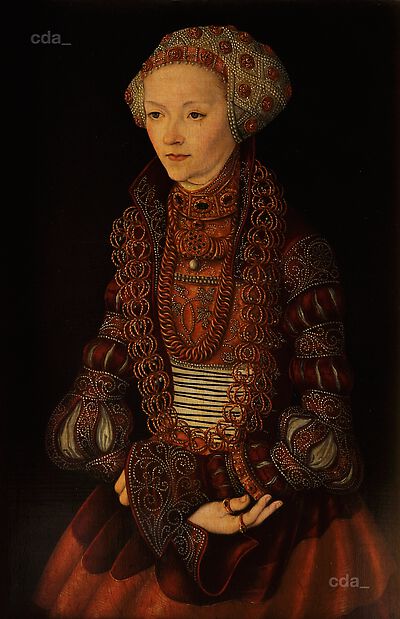[...] A letter to Elector Johann Friedrich on the 27 February 1534 from Anna’s daughter Elizabeth (1502-1557), who was married to Duke Johann the Steadfast (1498 -1537), reveals that the elector's court painter (‘mester Luckes’) executed two portraits of Elizabeth – for herself and for Elector Johann Friedrich – as well as a portrait of her mother (‘m. fraw mutter selgen kounterfett’). [1] It may be assumed that the portrait was completed before Anna’s death in 1525. Neither the portraits of Elisabeth nor that of her mother have yet surfaced or been identified. [2] In this regard a restricted view within the research on Cranach can be observed as in attempts to identify sitters generally only members of the Saxon electoral circle are taken into account and as a result female portraits are usually considered to be depictions of Saxon princesses. The Portrait of a Lady, which is signed with Cranach’s insignia and bears the date ‘1515’ is presented in this context as an example. [3] On the basis of the date alone the sitter cannot be - as had been suggested in the past - Saxon Duchess Sybille of Cleve, as she at this time would only have been three years of age. [4] Nevertheless it was assumed that a different Saxon Lady was depicted here. However it could equally be a woman from different ducal house. It is tempting – even though conclusive evidence is lacking – to identify the sitter as landgravine Anna. She would have been 30 years old when the painting was created and was generally considered very pretty, earning her the title ‘Frau Venus’ at the imperial court. Her penchant for precious jewelry, which led to friction with her son, is documented and matches well with the portrait. [5] After all the bonnet is decorated with the initial ‘H’ embroidered with pearls, which could refer to the Landgraviate of Hesse. The historical situation was also favorable, making the portraiture of the landgravine particular plausible at this time. In1514 after an almost five year dispute with the hessian baronetage Anna was finally recognized as regent at the Landtag in Homberg, as had been designated in her husband’s second testament from 1508. [6] In the winter of 1514/15 she resided at the imperial court in Innsbruck where she promised Maximilian I. that she would transfer the government of the Landgraviate to her son on his 14th birthday. [7] A portrait of the now acknowledged regent would appear conceivable at this time or shortly after. [8] Furthermore in 1515 the marriage of Anna’s daughter Elizabeth to Duke Johann the Steadfast was arranged. [9] Even if it must remain conjecture whether or not the portrait presented here depicts the landgravine, according to the letter from her daughter one must have existed.
[1] "Auf E. L. beger hatt mich mester Lukes gestern ab gemallet. E. L. wert aber wenck schonest an mir sen. Ich byt, E. L. wol mir E. L. angesych gemallet auch scheycken sammt E. L. gemal, schwestern und keynttern, und E. L. wol mester Luckest schreiben, das er mir m. fraw mutter selgen kounterfett auch scheycken will, dan mester Luckest hatt es noch, und meyn schoune gestal auch.", Werl 1965, 23-37, here 27.
[2] The identity of the two almost identical portraits of courtly ladies in Darmstadt and Lyon suggested by Werl – as tempting as it may be – is not accurate as the sitters are both wearing a bride’s garland. See Exhib. Cat. Basel 1974, No. 627.
[3] 53.3 x 37.4 cm, wooden panel, Waddesdon Manor, The Rothschild Collection (on permanent loan from the Rotheschild Family Trust), Inv. No. 138.1996. I would like to thank Rachel Jacobs, Waddesdon Manor for providing information and a photographic image.
[4] See the entry by Philippa Plock in the collection database http://collection.waddesdon.org.uk
[5] Puppel 2004; Köttelwesch 2013, 15.
[6] Puppel 2004, 50f.
[7] Puppel 2005, 60.
[8] In addition in 1514Cranach created a large format portrait of Anna’s younger sister Catharine and her husband Duke Heinrich of Saxony, Exhib. Cat. Chemnitz 2005, 424-431.
[9] Exhib. Cat. Marburg 2004, 192; Tieme 2010, 14-16.
[Lange 2015, 33-35]
